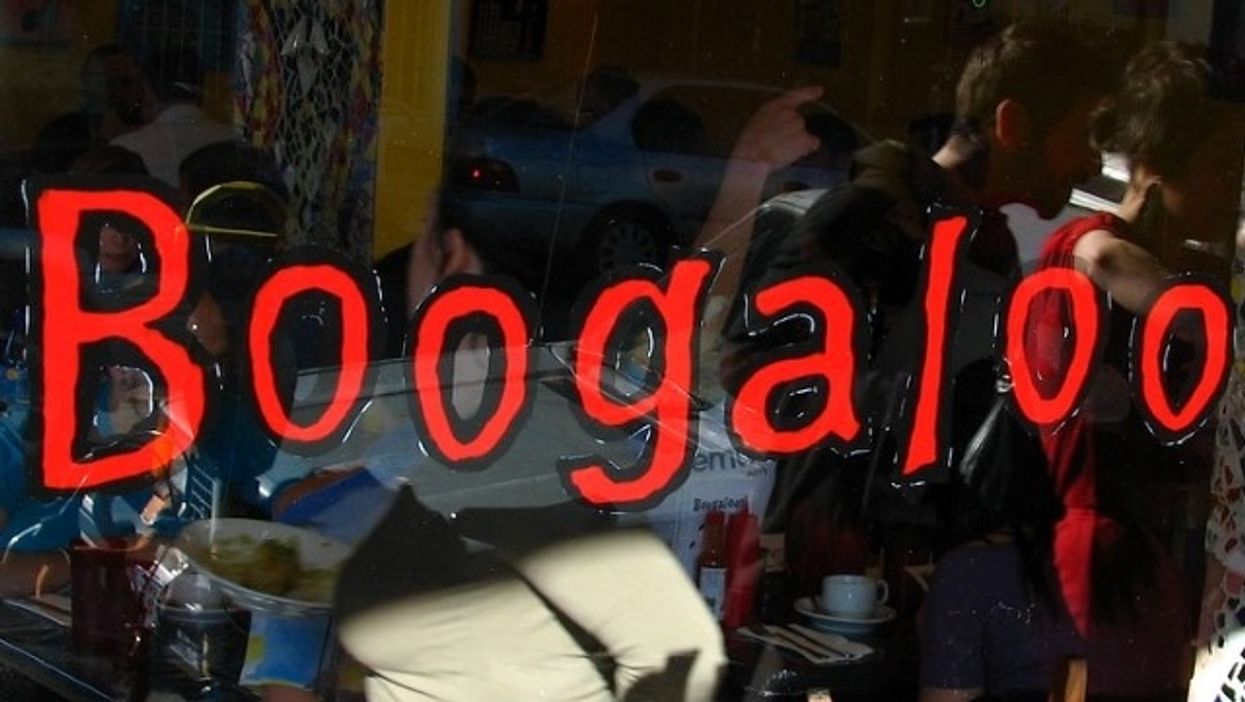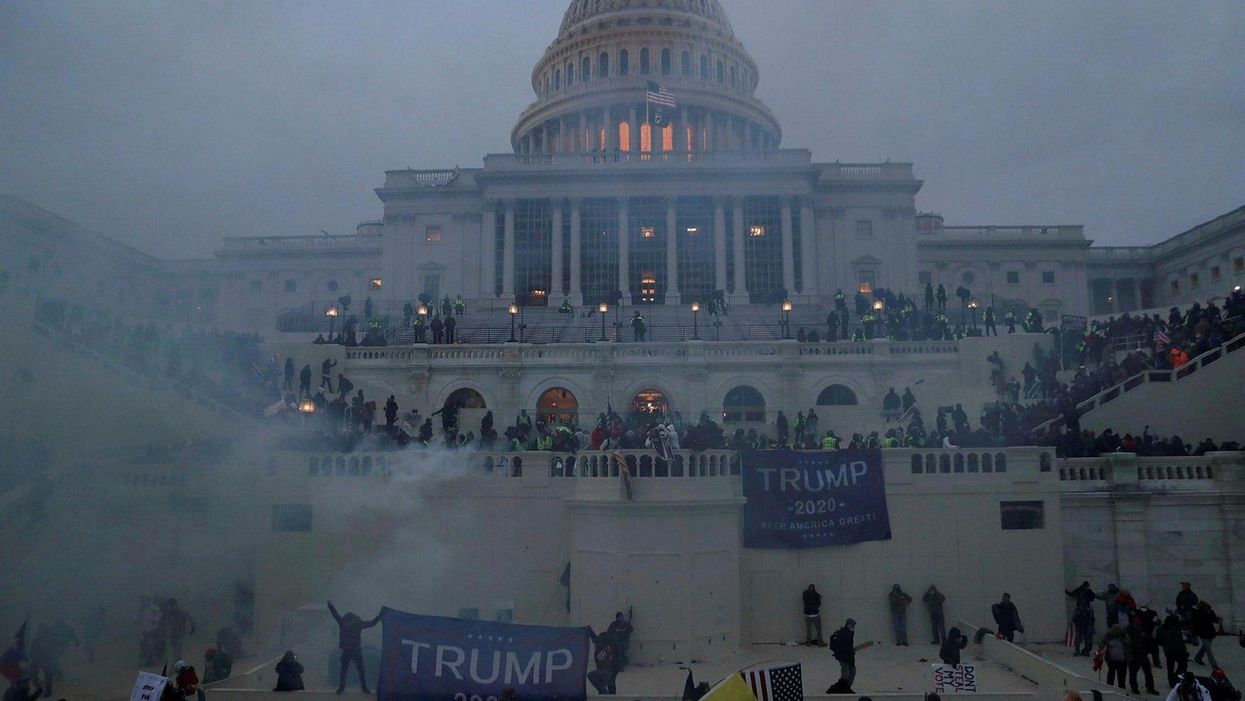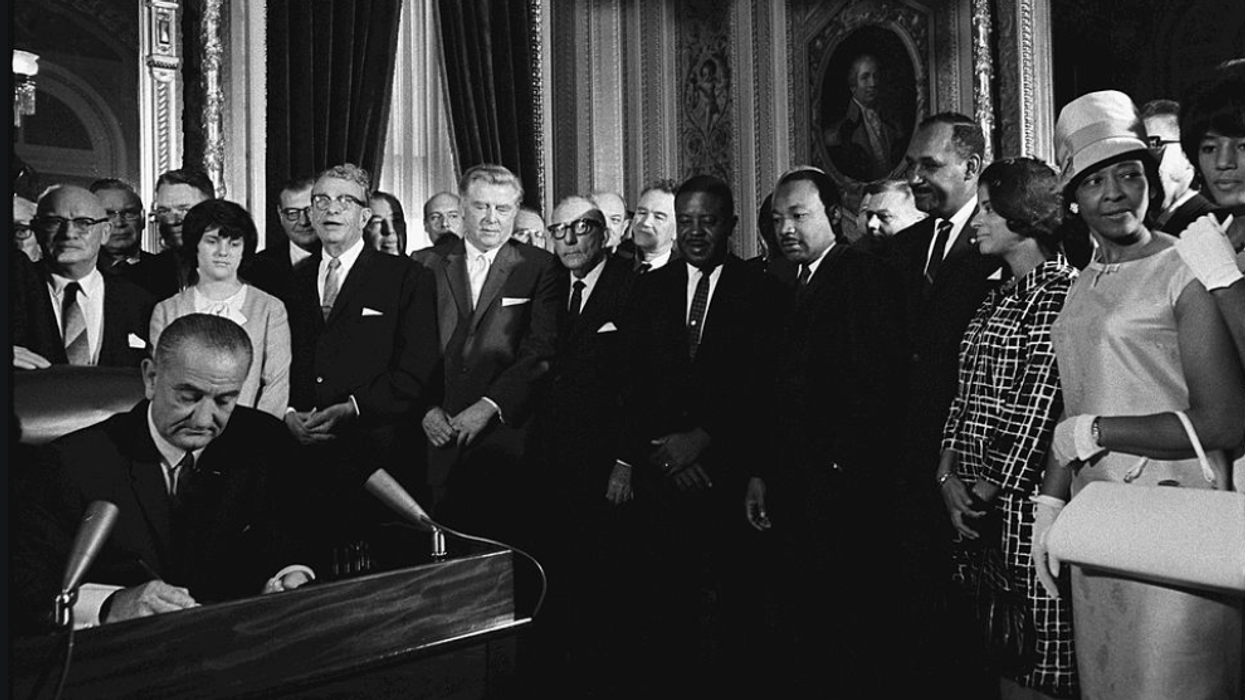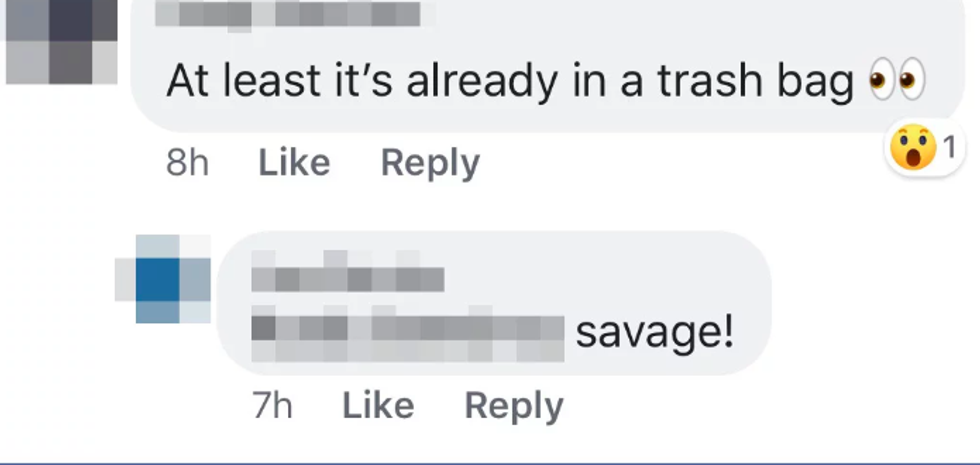Seeking To Overthrow Government, 'Boogaloo Bois’ Have Guns — And Criminal Records
ProPublica is a nonprofit newsroom that investigates abuses of power. Sign up to receive our biggest stories as soon as they're published. This story is part of an ongoing collaboration between ProPublica and FRONTLINE that includes an upcoming documentary.
Hours after the attack on the Capitol ended, a group calling itself the Last Sons of Liberty posted a brief video to Parler, the social media platform, that appeared to show members of the organization directly participating in the uprising. Footage showed someone with a shaky smartphone charging past the metal barricades surrounding the building. Other clips show rioters physically battling with baton-wielding police on the white marble steps just outside the Capitol.
Before Parler went offline — its operations halted at least temporarily when Amazon refused to continue to host the network — the Last Sons posted numerous statements indicating that group members had joined the mob that swarmed the Capitol and had no regrets about the chaos and violence that unfolded on Jan. 6. The Last Sons also did some quick math: The government had suffered only one fatality, U.S. Capitol Police Officer Brian Sicknick, 42, who was reportedly bludgeoned in the head with a fire extinguisher. But the rioters had lost four people, including Ashli Babbitt, the 35-year-old Air Force veteran who was shot by an officer as she tried to storm the building.
In a series of posts, the Last Sons said her death should be "avenged" and appeared to call for the murder of three more cops.
The group is part of the Boogaloo movement — a decentralized, very online successor to the militia movement of the '80s and '90s — whose adherents are fixated on attacking law enforcement and violently toppling the U.S. government. Researchers say the movement began coalescing online in 2019 as people — mostly young men — angry with what they perceived to be increasing government repression, found each other on Facebook groups and in private chats. In movement vernacular, Boogaloo refers to an inevitable and imminent armed revolt, and members often call themselves Boogaloo Bois, boogs or goons.
In the weeks since Jan. 6, an array of extremist groups have been named as participants in the Capitol invasion. The Proud Boys. QAnon believers. White nationalists. The Oath Keepers. But the Boogaloo Bois are notable for the depth of their commitment to the overthrow of the U.S. government and the jaw-dropping criminal histories of many members.
Mike Dunn, a 20-year-old from a small town on Virginia's rural southern edge, is the commander of the Last Sons. "I really feel we're looking at the possibility — stronger than any time since, say, the 1860s — of armed insurrection," Dunn said in an interview with ProPublica and FRONTLINE a few days after the assault on the Capitol. Although Dunn didn't directly participate, he said members of his Boogaloo faction helped fire up the crowd and "may" have penetrated the building.
"It was a chance to mess with the federal government again," he said. "They weren't there for MAGA. They weren't there for Trump."
Dunn added that he's "willing to die in the streets" while battling law enforcement or security forces.
In its short existence, the Boogaloo movement has proven to be a magnet for current or former military service members who have used their combat skills and firearms expertise to advance the Boogaloo cause. Before becoming one of the faces of the movement, Dunn did a brief stint in the U.S. Marines, a career he says was cut short by a heart condition, and worked as a Virginia state prison guard.
Through interviews, extensive study of social media and a review of court records, some previously unreported, ProPublica and FRONTLINE identified more than 20 Boogaloo Bois or sympathizers who've served in the armed forces. Over the past 18 months, 13 of them have been arrested on charges ranging from the possession of illegal automatic weapons to the manufacture of explosives to murder.
Most of the individuals identified by the news organizations became involved with the movement after leaving the military. At least four are accused of committing Boogaloo-related crimes while employed by one of the military branches.
Examples of the nexus between the group and the military abound.
Last year, an FBI task force in San Francisco opened a domestic terror investigation into Aaron Horrocks, a 39-year-old former Marine Corps reservist. Horrocks spent eight years in the Reserve before leaving the Corps in 2017.
The bureau became alarmed in September 2020, when agents received a tip that Horrocks, who lives in Pleasanton, California, was "planning an imminent violent attack on government or law enforcement," according to a petition to seize the man's firearms, which was filed in state court in October. The investigation, which has not previously been reported, links Horrocks to the Boogaloo movement. He has not been charged.
 A petition asking an Alameda County, California, court to bar Aaron Horrocks from owning firearms and ammunition. (Superior Court of California, County of Alameda)
A petition asking an Alameda County, California, court to bar Aaron Horrocks from owning firearms and ammunition. (Superior Court of California, County of Alameda)
Horrocks did not respond to a request for comment, though he has uploaded a video to YouTube that appears to show federal law enforcement agents, in plainclothes, searching his storage unit. "Go fuck yourselves," he tells them.
In June 2020 in Texas, police briefly detained Taylor Bechtol, a 29-year-old former Air Force staff sergeant and munitions loader with the 90th Aircraft Maintenance Unit. While in the service, Bechtol handled 1,000-pound precision-guided bombs.
The former airman was riding in a pickup truck with two other alleged Boogaloo Bois when the vehicle was stopped by Austin police, according to an intelligence report generated by the Austin Regional Intelligence Center, a multi-agency fusion center. Officers found five guns, several hundred rounds of ammunition and gas masks in the truck. The men expressed "sympathetic views toward the Boogaloo Bois" and should be treated with "extreme caution" by law enforcement, noted the report, which was obtained by ProPublica and FRONTLINE after it was leaked by hackers.
One of the men in the vehicle, Ivan Hunter, 23, has since been indicted for allegedly using an assault rifle to shoot up a police precinct in Minneapolis and helping to set the building ablaze. No trial date has been set for Hunter, who has pleaded not guilty.
Bechtol, who has not been charged with any wrongdoing in connection with the traffic stop, did not respond to a request for comment.
Linda Card, a spokeswoman for the Air Force Office of Special Investigations, which deals with the service's most complex and serious criminal matters, said Bechtol left the service in December 2018 and was never investigated while in the Air Force.
In perhaps the highest-profile incident involving the group, several Boogaloo Bois were arrested in October in connection with the widely reported plot to kidnap Michigan Gov. Gretchen Whitmer. One of those men was Joseph Morrison, a Marine Corps reservist who was serving in the 4th Marine Logistics Group at the time of his arrest and arraignment. Morrison, who is facing terrorism charges, went by the name Boogaloo Bunyan on social media. He also kept a sticker of the Boogaloo flag — it features a Hawaiian floral pattern and an igloo — on the rear window of his pickup truck. Two other men charged in the plot had spent time in the military.
The Marine Corps is working to root out extremists from its ranks, a spokesman said.
"Association or participation with hate or extremist groups of any kind is directly contradictory to the core values of honor, courage and commitment that we stand for as Marines and isn't tolerated," Capt. Joseph Butterfield said.
No reliable numbers exist about how many current or former military members are part of the movement.
However, military officials at the Pentagon told ProPublica and FRONTLINE that they have been concerned by a surge in extremist activity. "We are seeing an increase in concerning behavior," said one official, stressing that military leaders are "very actively" responding to tips and are thoroughly investigating service members linked to anti-government groups.
Experts worry about people with military training joining extremist groups.
Boogaloo Bois with military experience are likely to share their expertise with members who've never served in the armed forces, building a more effective, more lethal movement. "These are folks who can bring discipline to a movement. These are folks that can bring skills to a movement," said Jason Blazakis, director of the Center on Terrorism, Extremism, and Counterterrorism at Middlebury Institute of International Studies at Monterey.
Though some Boogaloo groups have made spectacular blunders — among them, sharing information with undercover FBI agents and using unencrypted messaging services to communicate — the movement's familiarity with weapons and basic infantry techniques clearly poses serious challenges for law enforcement.
"We have the upper hand," Dunn said. "A lot of the guys have knowledge that your normal civilians do not have. Police officers are not used to combating that kind of knowledge."
"It Wasn't Talk"
The marriage of extremist ideology and military skill was apparent in an alleged plot last year to attack police officers at a racial justice protest.
On a hot spring evening last May, an FBI SWAT team swarmed on three alleged Boogaloo Bois as they met in the parking lot of a 24 Hour Fitness club on the east side of Las Vegas. Agents found a small arsenal in the trio's vehicles: a shotgun, a handgun, two rifles, plenty of ammunition, body armor and materials that could be used to make Molotov cocktails — glass bottles, gasoline and rags torn into small pieces.
All three men had military experience. One had served in the Air Force. Another the Navy. The third, 24-year-old Andrew Lynam, was in the U.S. Army Reserve at the time of the arrests. During his teenage years Lynam attended the New Mexico Military Institute, a public academy that prepares high school and junior college students for careers in the armed forces.
In court, federal prosecutor Nicholas Dickinson portrayed Lynam as the leader of the group, a Nevada-based Boogaloo cell called Battle Born Igloo. "The defendant associated with the Boogaloo movement; i.e., he referred to himself as a Boogaloo Boi," the prosecutor told the court during a June detention hearing, according to a transcript. Lynam, continued Dickinson, "corresponded with other Boogaloo groups, especially in California, Denver and Arizona. Essentially, the defendant was radicalized to the point where he wanted to act out, it wasn't talk."
According to the prosecutor, the men intended to join a protest over the death of George Floyd and hurl firebombs at police, and they had made plans to bomb an electric power substation and a federal building, actions they hoped would spark a wider anti-government uprising.
"They wanted to damage or destroy some sort of government building or infrastructure to get the response of law enforcement and, hopefully, the overreaction of the federal government," Dickinson told the court.
The prosecutor said he found it particularly "troubling" that Lynam was serving in the military while at the same time plotting to attack government infrastructure.
During the June hearing, defense lawyer Sylvia Irvin pushed back, criticizing the "clear weaknesses" in the government's case, challenging the credibility of an FBI informant and suggesting Lynam was really a minor player in the group.
Lynam, who has pleaded not guilty, is now represented by attorney Thomas Pitaro, who did not respond to requests for comment. Lynam and his co-defendants, Stephen Parshall and William Loomis, are also facing a parallel slate of charges brought by local prosecutors in state court. Parshall and Loomis have pleaded not guilty.
A spokesman for the Army Reserve said Lynam, a medical specialist who joined in 2016, currently holds the rank of private first class in the service. He has never deployed to a combat zone. "Extremist ideologies and activities directly oppose our values and beliefs, and those who subscribe to extremism have no place in our ranks," said Lt. Col. Simon Flake, noting that Lynam is facing disciplinary action by the Army when his criminal cases conclude.
"An Insider Threat"
The body of criminal law that governs the armed forces, the Uniform Code of Military Justice, doesn't include an explicit prohibition on joining extremist groups.
But participation in criminal gangs, white supremacist organizations and anti-government militias is barred by a 2009 Pentagon directive that covers all military branches. Service members who violate that ban can face court-martial for disobeying a lawful order or regulation, or for other offenses related to their extremist activity, such as making false statements to superiors. Military prosecutors can also use a catchall provision of the military code called Article 134 — or the general article — to charge service members who've engaged in conduct that brings "discredit" to the armed forces or harms the "good order and discipline" of the military, said Geoffrey Corn, a retired Army officer who served as a military attorney and who now teaches national security law at South Texas College of Law Houston.
Pointing to the Oklahoma City bomber, Timothy McVeigh, who enlisted in the Army and served in the first Gulf War, Corn said it's no secret that the military has been a "breeding ground" for extremism to some extent for decades. McVeigh's devastating 1995 attack on that city's Alfred P. Murrah federal building killed 168 people, many of them children.
Military officials have acknowledged an uptick in extremist activity and domestic terrorism cases in recent years.
Addressing a congressional committee last year, Joe Ethridge, intelligence chief for the Army's Criminal Investigation Command, said his staff had opened seven investigations into allegations of extremist activity in 2019, up from an average of 2.4 per year during the previous half decade. "During the same time period, the Federal Bureau of Investigation notified CID of an increase in domestic terrorism investigations with soldiers or former soldiers as suspects," he told members of the House Armed Services Committee.
Ethridge also noted that most soldiers who are flagged for extremist behavior face administrative sanctions — including counseling or retraining — rather than criminal prosecution.
In the aftermath of the Capitol attack and a flurry of news reports documenting the involvement of service members in the chaos, the Department of Defense announced a comprehensive review of its policies on extremist and white supremacist activity to be conducted by the Pentagon's inspector general.
"We in the Department of Defense are doing everything we can to eliminate extremism" within the military, Garry Reid, a director for defense intelligence at the Pentagon, told ProPublica and FRONTLINE. "All military personnel, including members of the National Guard, have undergone a background investigation, are subject to continuous evaluation and are enrolled in an insider threat program."
The "Kill House"
The military is clearly worried about Boogaloo Bois training up civilians. Last year, the Naval Criminal Investigative Service, the law enforcement agency that investigates felony-level crimes involving sailors and members of the Marine Corps, circulated an intelligence bulletin.
Called a threat awareness message, the bulletin detailed the arrests of Lynam and the other men in Las Vegas and noted that Boogaloo followers have engaged in discussions about "recruiting military or former military members for their perceived knowledge of combat training."
NCIS concluded the bulletin with a warning: The agency couldn't ignore the possibility that individuals involved with the Boogaloo movement were serving throughout the military. "NCIS continues to emphasize the importance of reporting suspected boogaloo activity through the chain of command."
The subject came up during a court hearing in Michigan involving Paul Bellar, one of the men arrested on state charges in connection with the plot to kidnap Whitmer. "It's my understanding Mr. Bellar used his military training to teach combat procedures to members of this terrorist group," said Magistrate Frederick Bishop, explaining his reluctance to lower Bellar's bail during the October hearing. Bellar, who has since been released from jail on bond, has pleaded not guilty.
In another instance, an ex-Marine gathered at least six men at a wooded property in McLoud, Oklahoma, a small town outside of Oklahoma City, and taught them how to storm a building. In a video posted to YouTubelast year, the former Marine, Christopher Ledbetter, shows the group how to enter a house and kill any enemy combatants inside. Filmed with a GoPro camera, the video concludes with Ledbetter, who served in the Marine Corps from 2011 to 2015, blasting a wooden target with a barrage of bullets from a fully automatic AK-47-type carbine.
Ledbetter called his training facility the " kill house," according to court records.
A series of Facebook Messenger conversations obtained by the FBI show that Ledbetter, 30, identified with the Boogaloo movement and was preparing for the coming armed insurrection, which he thought would be a "blast." In an interview, Ledbetter told agents that he had been manufacturing hand grenades and admitted that he had modified his AK-47 so that it would fire automatically.
 A transcript of Facebook messages between Christopher Ledbetter and a Facebook user. Ledbetter said, "Can't keep the goons" — a nickname for Boogaloo members — "from finding each other." (United States District Court for the Western District of Oklahoma)
A transcript of Facebook messages between Christopher Ledbetter and a Facebook user. Ledbetter said, "Can't keep the goons" — a nickname for Boogaloo members — "from finding each other." (United States District Court for the Western District of Oklahoma)
Ledbetter pleaded guilty in December to illegal possession of a machine gun. He is currently serving a 57-month sentence in federal custody.
On an hourlong podcast posted in May 2020, two Boogaloo Bois discussed, in detail, how to do battle with the government.
One of the men, who dispenses combat advice online using the handle Guerrilla Instructor, said he had enlisted in the Army but had eventually grown disenchanted and left the service. The other man, who called himself Jake, said he was currently serving as a military police officer in the Army National Guard.
Traditional infantry tactics wouldn't be particularly useful during the coming civil war, opined Guerrilla Instructor, arguing that sabotage and assassination would be more helpful for the anti-government insurgents. It was simple, he said: A Boogaloo Boi could just walk up to a government figure or law enforcement officer on the street and "shoot them in the face" before fleeing.
But there was another assassination technique that held special appeal for Guerrilla Instructor. "I believe honestly that drive-bys will be our greatest tool," he said, sketching out a scenario in which three Boogs would hop in an SUV, spray a target with gunfire, "kill some dudes" and speed off.
"That's some real gangster shit right there," enthused Jake.
"Boog"
About three weeks after the podcast was uploaded to Apple and other podcast distributors, a security camera tracked a white Ford van as it moved through the darkened streets of downtown Oakland, California. It was 9:43 p.m.
Inside the vehicle, prosecutors say, were Boogaloo Bois Steven Carrillo, who was armed with an automatic short-barreled rifle, and Robert Justus, Jr., who was driving. As the van rolled along Jefferson Street, Carrillo allegedly flung open the sliding door and unleashed a burst of gunfire, hitting two federal protective services officers posted outside the Ronald V. Dellums federal building and courthouse. The barrage killed David Patrick Underwood, 53, and wounded Sombat Mifkovic, whose age has not been released.
At this point, there's no evidence Carrillo — a 32-year-old Air Force staff sergeant stationed at Travis Air Force Base in Northern California — ever heard the podcast or communicated with the men who recorded it. But, obviously, his alleged crime closely resembles the assassination strategies discussed on the show, which is still available online. He is facing murder and attempted murder charges in federal court, to which he has pleaded not guilty.
According to the FBI, Carrillo used an exotic and highly illegal weapon to carry out the shooting: an automatic rifle with an extremely short barrel and a silencer. The weapon, which fires 9 mm ammunition, is a so-called ghost gun — it lacks any serial numbers, making it difficult to trace.
Built from machined aluminum, heavy-duty polymers or even 3D printed plastic, ghost guns have been embraced by Boogaloo movement members, many of whom take an absolutist position on the Second Amendment, arguing that the government lacks any authority to restrict gun ownership.
Last year police in New York state arrested an Army drone operator and alleged Boogaloo Boi on charges that he owned an illegal ghost gun. Noah Latham, a private based at Fort Drum, did a tour of Iraq as a drone operator, according to an Army spokesperson. Latham was discharged from the service after he was arrested by police in Troy in June 2020.
The shootings at the courthouse in Oakland were only the first chapter in Carrillo's alleged rampage. In the days after, he headed about 80 miles south, to a tiny town nestled in the Santa Cruz mountains. There he allegedly got into a gun battle with Santa Cruz County sheriff's deputies and state police, a shootout that killed deputy Damon Gutzwiller, 38, and injured two other law enforcement officers. According to prosecutors, who have charged Carrillo with premeditated murder and a host of other felonies in state court, Carrillo also hurled homemade bombs at the cops and deputies and carjacked a Toyota Camry in a bid to escape.
Before ditching the car, Carrillo apparently used his own blood — he was hit in the hip during the skirmish — to write the word "Boog" on the hood of the car.
Heidi Beirich, co-founder of the Global Project Against Hate and Extremism, has monitored the links between the military and extremist groups for years, tracking each policy tweak, every criminal case. In her view, Carrillo's grisly narrative is a product of the military's refusal to adequately address the issue of radicalization within the ranks. She said, "The failure to deal with this problem on the part of the armed forces" has "unleashed people who are highly trained in how to kill" on the public.
Zoe Todd, FRONTLINE, contributed reporting.



 Henry "Enrique" Tarrio's Parler post in late December.Screenshot from ProPublica.
Henry "Enrique" Tarrio's Parler post in late December.Screenshot from ProPublica. Stewart Rhodes, founder of the Oath Keepers, at the Capitol on Wednesday. (Ford Fischer)Screenshot from ProPublica.
Stewart Rhodes, founder of the Oath Keepers, at the Capitol on Wednesday. (Ford Fischer)Screenshot from ProPublica.













